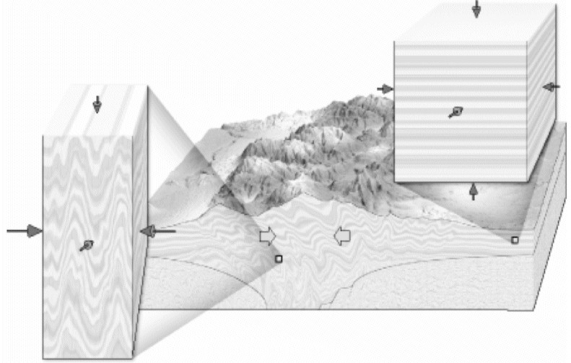B) False
Correct Answer

verified
Correct Answer
verified
Multiple Choice
Examine the words and/or phrases for each question below and determine the relationship among the majority of words/phrases. -Choose the option that does not fit the pattern.
A) porphyroblastic
B) slaty cleavage
C) schistosity
D) gneissic texture
F) All of the above
Correct Answer

verified
Correct Answer
verified
Multiple Choice
Which facies would you expect to find with high temperature-low pressure contact metamorphism?
A) hornfels
B) amphibolite
C) granulite
D) blueschist
F) A) and C)
Correct Answer

verified
Correct Answer
verified
Multiple Choice
Examine the words and/or phrases for each question below and determine the relationship among the majority of words/phrases. -Choose the option that does not fit the pattern.
A) phyllite
B) quartzite
C) slate
D) schist
F) All of the above
Correct Answer

verified
Correct Answer
verified
Short Answer
What type of stress (pressure)is illustrated in the diagram below?

Correct Answer

verified
Correct Answer
verified
Short Answer
Give the name of a rock formed by regional metamorphism of a conglomerate.
Correct Answer

verified
Correct Answer
verified
Multiple Choice
Which two metamorphic rocks are each composed predominantly of a single mineral?
A) mica schist and granitic gneiss
B) fault breccia and graphitic schist
C) garnet schist and andalusite hornfels
D) marble and quartzite
F) A) and B)
Correct Answer

verified
Correct Answer
verified
Multiple Choice
Amphibolite is a foliated metamorphic rock composed principally of hornblende and plagioclase.How does it form?
A) by contact metamorphism of quartzose sandstone cut by a granitic batholith
B) by regional metamorphism of volcanic rocks such as andesite and basalt
C) by gouging and crushing of limestone along a fault
D) by the impact of an asteroid on interbedded sandstone and shale
F) A) and B)
Correct Answer

verified
Correct Answer
verified
Multiple Choice
The intensity and grade of ________ metamorphism is most intense where ________.
A) burial (zeolite facies) , the soil horizon gives way to unaltered bedrock
B) cataclastic (dynamic) , muds are shattered by raindrop impacts
C) contact, clays are recrystallized and reacted entirely to chlorite
D) regional, continents collide forming a mountain belt
F) All of the above
Correct Answer

verified
Correct Answer
verified
Multiple Choice
Graphite is identified in a particular schist.Which one of the following conclusions is justified?
A) The rock also contains diamonds; both are crystalline forms of the element carbon.
B) The schist formed from a quartz-rich, sedimentary limestone.
C) The graphite lubricated shearing movements along a fault, causing a schist to form.
D) The pre-metamorphic rock was a shale or mudstone containing organic matter.
F) B) and C)
Correct Answer

verified
Correct Answer
verified
Multiple Choice
________ is a nonfoliated rock formed by the contact metamorphism of fine grained rocks like shales, mudstones, or volcanics.
A) Schist
B) Marble
C) Gneiss
D) Hornfels
F) B) and D)
Correct Answer

verified
Correct Answer
verified
Multiple Choice
Where would you expect to find chlorite and zeolites filling up voids and fractures in relatively undeformed rocks?
A) burial metamorphism of sedimentary or volcanic rocks
B) intermediate grade metamorphism of limestones
C) high grade metamorphism of layered sandstones and shales
D) high temperature hornfels contact metamorphism of salts and rock gypsum
F) A) and B)
Correct Answer

verified
Correct Answer
verified
Multiple Choice
In which setting would regional metamorphism most likely occur?
A) at shallow depths below an oceanic ridge or rift zone
B) at shallow depths along major transform faults on the continental crust
C) at great depths in the crust where two continents are colliding
D) on the rims of large meteorite impact craters
F) B) and C)
Correct Answer

verified
Correct Answer
verified
Short Answer
What two index minerals characterize the eclogite facies?
Correct Answer

verified
Correct Answer
verified
Short Answer
What medium grade regional metamorphic rock is produced from shale as the parent rock?
Correct Answer

verified
Correct Answer
verified
Multiple Choice
Which rock forms by contact metamorphism of fine grained mudstones, shales, and volcanics?
A) hornfels
B) limestone
C) gneiss
D) phyllite
F) All of the above
Correct Answer

verified
Correct Answer
verified
Multiple Choice
________ contain the oldest dated metamorphic rocks in Canada.
A) The Acasta Gneiss, Northwest Territories
B) The Grenville Province
C) The Nuwuagittuq Greenstone, Quebec
D) The Ungava Orogen
F) All of the above
Correct Answer

verified
Correct Answer
verified
Short Answer
What is another term for gneissic texture?
Correct Answer

verified
Correct Answer
verified
Multiple Choice
Examine the words and/or phrases for each question below and determine the relationship among the majority of words/phrases. -Choose the option that does not fit the pattern.
A) aureole
B) hornfels
C) marble
D) schist
F) C) and D)
Correct Answer

verified
Correct Answer
verified
Multiple Choice
In the formation of migmatites, which minerals start to melt first?
A) amphibole, biotite, and garnet
B) quartz and feldspar
C) chlorite and calcite
D) zircon and magnetite
F) A) and B)
Correct Answer

verified
Correct Answer
verified
Showing 21 - 40 of 143
Related Exams